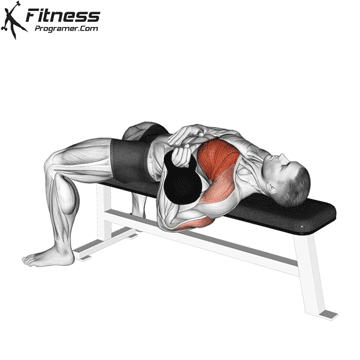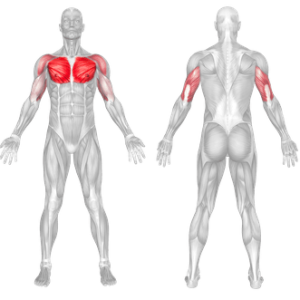One-Arm Kettlebell Chest Press Overview
The One-Arm Kettlebell Chest Press is a unilateral pressing exercise that involves lifting a kettlebell with one arm while lying flat on a bench or the floor. Unlike traditional barbell or dumbbell presses, the off-centered weight of the kettlebell challenges your grip, stability, and core engagement.
This exercise is ideal for developing functional strength, correcting muscle imbalances, and improving coordination. It is often used in functional fitness, athletic training, and rehabilitation protocols to balance upper body strength.
How to Perform

- Set-Up:
- Lie flat on a bench or the floor with your knees bent and feet firmly planted.
- Hold a kettlebell in one hand, keeping your wrist straight and your palm facing forward.
- Starting Position:
- Press the kettlebell directly above your chest, locking your elbow.
- Ensure the kettlebell rests against the back of your forearm for stability.
- Lowering Phase:
- Slowly lower the kettlebell toward your chest, keeping your elbow at a 45-degree angle from your torso.
- Focus on controlling the descent to engage your stabilizing muscles.
- Pressing Phase:
- Push the kettlebell back to the starting position in a straight line.
- Exhale as you press up and maintain control throughout the movement.
- Switch Arms:
- Complete the desired repetitions and then switch to the other arm.
Tips for Proper Form
- Keep Your Core Tight: Engage your core to prevent your torso from twisting or arching.
- Stable Grip: Ensure the kettlebell handle remains stable and secure in your hand.
- Controlled Movement: Avoid rushing; control both the lowering and lifting phases.
- Breathing: Inhale as you lower the kettlebell and exhale as you press it back up.
- Shoulder Position: Keep your shoulder blades retracted and pressed against the bench or floor.
Common Mistakes
- Arching the Back: Overarching the lower back reduces core engagement and increases injury risk.
- Rushing the Movement: Performing the exercise too quickly can compromise form and reduce effectiveness.
- Poor Grip: A weak grip can lead to instability and reduce the safety of the exercise.
- Elbow Flare: Allowing the elbow to flare out excessively can stress the shoulder joint.
Benefits of the One-Arm Kettlebell Chest Press
- Enhanced Upper-Body Strength: Builds strength in the chest, shoulders, and triceps.
- Improved Core Stability: The unilateral nature of the exercise challenges your core to maintain balance.
- Muscular Symmetry: Addresses strength imbalances between the left and right sides.
- Functional Strength: Improves coordination, grip strength, and overall stability, which translates to real-world activities.
- Injury Prevention: Strengthens stabilizing muscles and promotes better shoulder mechanics, reducing injury risk.
- Rehabilitation: Useful for rebuilding strength after injury, under professional guidance.
How to Incorporate Into Your Routine
- Strength Training: Include the One-Arm Kettlebell Chest Press in your upper-body workout, performing 3–4 sets of 8–12 reps per arm.
- Functional Fitness: Pair with lower-body or rotational movements, such as kettlebell lunges, for a full-body functional circuit.
- Rehabilitation: Use a lighter kettlebell under supervision to rebuild stability and strength post-injury.
- Warm-Up or Activation: Perform a few light sets to activate your core and upper-body muscles before heavier pressing exercises.
- Progressions: Increase the kettlebell weight, perform on a stability ball, or add a tempo variation to further challenge your strength and stability.
Muscles worked

